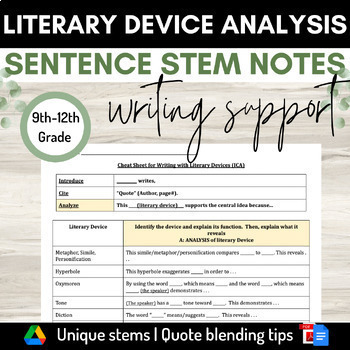Literary Device Analysis Sentence Stem Notes Sheet
- Google Drive™ folder

Description
Looking for a one-stop-shop of literary device analysis sentence stems notes sheet? This analyzing literary device sentence stem notes (cheat sheet) has it all in one place!
Each device has a unique sentence stem for deep analysis of how the device develops a central idea.
The "ICA" acronym method is included to help students blend quotes by introducing, citing, and analyzing their evidence.
Additional information:
- This resource is universally designed: sentence stems, prompts, blending quote analyses acronym, and graphic organizer.
- This resource can be used as print PDF and digital google docs.
- This outline is aligned with the 11th-grade English Language Arts New York State Regents Exam.
- This resource is suitable for 6th-grade English, 7th-grade English, 8th-grade English, 9th-grade English, 10th-grade English, 11th-grade English, and 12th-grade English.
Related Products: (all aligned to NYS English Regents Exam)
- Central Idea & Blending Supporting Quotes Practice
- Literary Devices Definitions & Examples Notes




